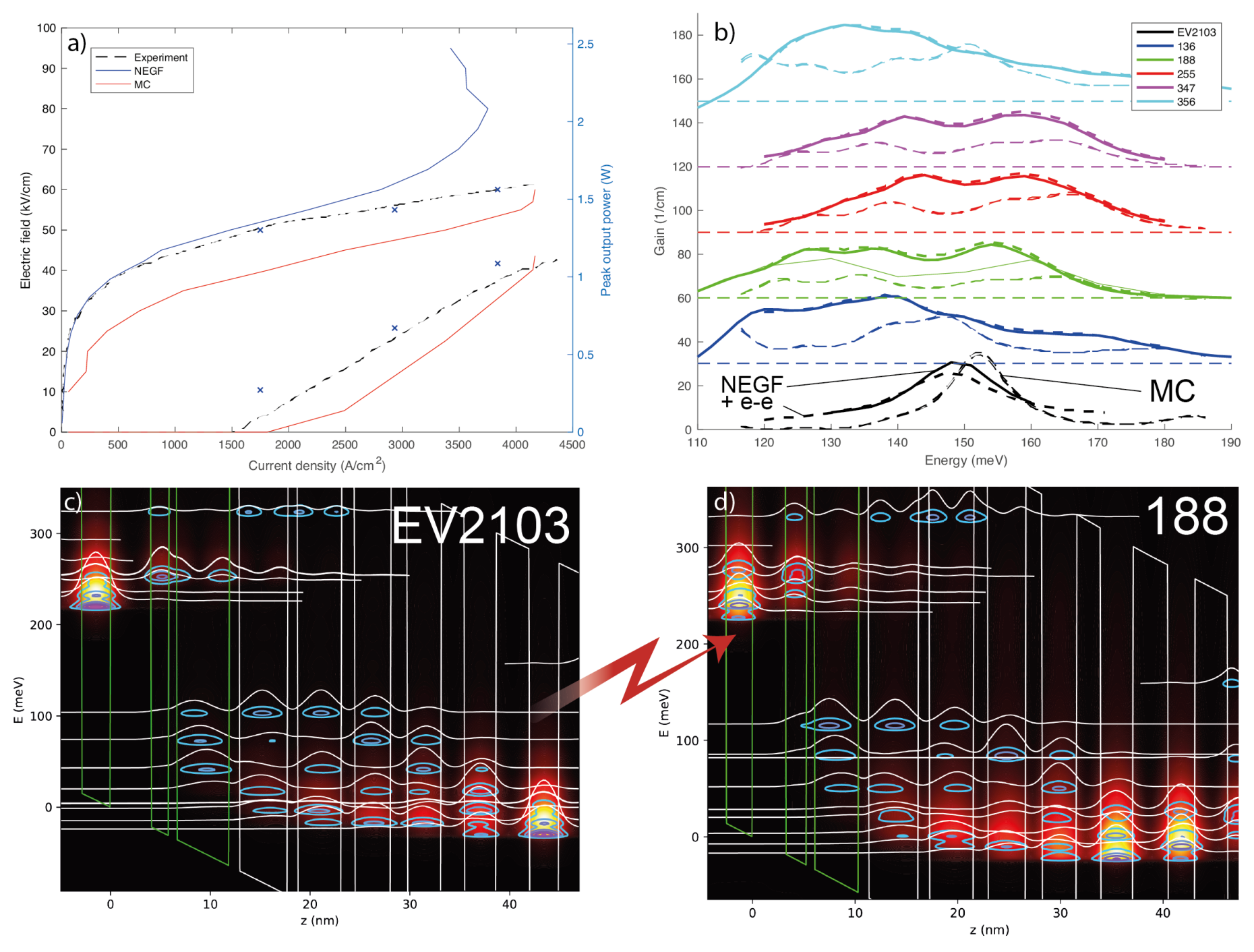By Design
Mid-IR QCL frequency combs[2] are already used in commercial applications such as dual-comb spectroscopy[3]. They are also promising sources for metrology, provided the spectral noise is reduced, e. g. by locking the carrier offset frequency and/or the repetition frequency. A broad comb spectrum is preferable for several applications, and octave spanning combs would enable self-referencing, allowing locking of the carrier offset frequency. A wide comb spectrum requires low dispersion, high output power, and a spectrally broad gain of the active region. Here, we focus on the latter by optimization using a nonequilibrium Green’s function (NEGF) model[4][5] and the open source QCL optimization tool “aftershoq”[6]. We compare the resulting structures to simulations with an ensemble Monte-Carlo (EMC) model[7][8], where the electron-electron (e-e) scattering can be fully accounted for in a semi-classical way. This allows us to validate the performance of the improved designs.
In order to validate the models, we benchmarked them on the original structure, and found similar results for the laser characteristics, as seen in Fig. 1 (a). We then optimized the integrated gain over the energy range 120-180 meV, divided by the maximum gain in order to suppress high and narrow gain curves, at a lattice temperature of 300 K. This merit function favors a broad and flat gain profile. In the optimization, five layers, marked in green in Fig. 1 (c)-(d), around the lasing transition were varied starting from the original structure. We adopted the “Information algorithm with parallel trials” [9] implemented in aftershoq [6], which optimizes efficiently over a 1D functions. Therefore, we map our 5D parameter space onto a 1D Hilbert curve as shown in Fig. 2.
The gain spectra of the original[10] (EV2103) and the five best devices from the optimization are shown in Fig. 1(b). The optimized structures have significantly broader gain than the original one, and the spectra are also flatter showing the benefit of the selected merit function. Assuming total waveguide and mirror losses of 8 cm-1, the usable width of the gain curve is twice the original value and covers the whole investigated frequency range for the structure labelled 356. In Fig. 1(b) we also see that while e-e scattering results in a reduction of the gain for the original structure, the effect is negligible for the other structures. This is explained by the small e-e scattering strength compared to the dominant contribution from impurities and interface roughness.
The EMC simulations validate the broader gain and the small impact of e-e scattering for the optimized designs. However, the EMC model predicts a lower and blue-shifted gain. This is caused by a red-shift of the injector and upper laser states due to the real part of the self-energy in the NEGF model, as well as the use of slightly different band parameters. This also results in a lower inversion in the EMC simulations, since the carriers do not tunnel as efficiently into the upper laser states. The comparison highlights the importance of both the choice of band structure parameters and the simulation model.
In summary, this first NEGF optimization of mid-IR QCL yielded 150% broader gain. Interestingly, the optimization algorithm modified design concept (from bound-to-continuum to continuum-to-continuum). We also see that non-parabolicity and band offsets are crucial for quantitative predictions of mid-IR QCL characteristics, and that overall, electron-electron scattering can be neglected.
References
[1] M. Gianella et al., “High-resolution and gapless dual comb spectroscopy with current-tuned quantum cascade lasers,” Opt. Express, vol. 28, no. 5, p. 6197, Mar. 2020, doi
[2] A. Hugi, G. Villares, S. Blaser, H. C. Liu, and J. Faist, “Mid-infrared frequency comb based on a quantum cascade laser,” Nature, vol. 492, no. 7428, pp. 229–233, Dec. 2012, doi
[3] G. Villares, A. Hugi, S. Blaser, and J. Faist, “Dual-comb spectroscopy based on quantum-cascade-laser frequency combs,” Nat. Commun., vol. 5, p. 5192, Oct. 2014, doi
[4] A. Wacker, M. Lindskog, and D. O. Winge, “Nonequilibrium Green’s Function Model for Simulation of Quantum Cascade Laser Devices Under Operating Conditions,” Sel. Top. Quantum Electron. IEEE J. Of, vol. 19, no. 5, p. 1200611, 2013, doi
[5] D. O. Winge, M. Franckié, C. Verdozzi, A. Wacker, and M. F. Pereira, “Simple electron-electron scattering in non-equilibrium Green’s function simulations,” J. Phys. Conf. Ser., vol. 696, no. 1, p. 012013, 2016, doi
[6] M. Franckié, aftershoq : A Flexible Tool for EM-Radiation-emitting Semiconductor Heterostructure Optimization using Quantum models. 2018. GitHub.
[7] C. Jirauschek and T. Kubis, “Modeling techniques for quantum cascade lasers,” Appl. Phys. Rev., vol. 1, no. 1, p. 011307, Feb. 2014, doi
[8] P. Tzenov, D. Burghoff, Q. Hu, and C. Jirauschek, “Time domain modeling of terahertz quantum cascade lasers for frequency comb generation,” Opt. Express, vol. 24, no. 20, pp. 23232–23247, Oct. 2016, doi
[9] Ya. D. Sergeev and R. G. Strongin, “A global minimization algorithm with parallel iterations,” USSR Comput. Math. Math. Phys., vol. 29, no. 2, pp. 7–15, Jan. 1989, doi
[10] A. Bismuto, R. Terazzi, M. Beck, and J. Faist, “Electrically tunable, high performance quantum cascade laser,” Appl Phys Lett, vol. 5, p. 141105, 2010, doi


